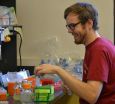(Press-News.org) Black and gray markets for computer hacking tools, services and byproducts such as stolen credit card numbers continue to expand, creating an increasing threat to businesses, governments and individuals, according to a new RAND Corporation study.
One dramatic example is the December 2013 breach of retail giant Target, in which data from approximately 40 million credit cards and 70 million user accounts was hijacked. Within days, that data appeared -- available for purchase -- on black market websites.
"Hacking used to be an activity that was mainly carried out by individuals working alone, but over the last 15 years the world of hacking has become more organized and reliable," said Lillian Ablon, lead author of the study and an information systems analyst at RAND, a nonprofit research organization. "In certain respects, cybercrime can be more lucrative and easier to carry out than the illegal drug trade."
The growth in cybercrime has been assisted by sophisticated and specialized markets that freely deal in the tools and the spoils of cybercrime. These include items such as exploit kits (software tools that can help create, distribute, and manage attacks on systems), botnets (a group of compromised computers remotely controlled by a central authority that can be used to send spam or flood websites), as-a-service models (hacking for hire) and the fruits of cybercrime, including stolen credit card numbers and compromised hosts.
In the wake of several highly-publicized arrests and an increase in the ability of law enforcement to take down some markets, access to many of these black markets has become more restricted, with cybercriminals vetting potential partners before offering access to the upper levels. That said, once in, there is very low barrier to entry to participate and profit, according to the report.
RAND researchers conducted more than two dozen interviews with cybersecurity and related experts, including academics, security researchers, news reporters, security vendors and law enforcement officials. The study outlines the characteristics of the cybercrime black markets, with additional consideration given to botnets and their role in the black market, and "zero-day" vulnerabilities (software bugs that are unknown to vendors and without a software patch). Researchers also examine various projections and predictions for how the black market may evolve.
What makes these black markets notable is their resilience and sophistication, Ablon said. Even as consumers and businesses have fortified their activities in reaction to security threats, cybercriminals have adapted. An increase in law enforcement arrests has resulted in hackers going after bigger targets. More and more crimes have a digital component.
The RAND study says there will be more activity in "darknets," more checking and vetting of participants, more use of crypto-currencies such as Bitcoin, greater anonymity capabilities in malware, and more attention to encrypting and protecting communications and transactions. Helped by such markets, the ability to attack will likely outpace the ability to defend.
Hyper-connectivity will create more points of presence for attack and exploitation so that crime increasingly will have a networked or cyber component, creating a wider range of opportunities for black markets. Exploitations of social networks and mobile devices will continue to grow. There will be more hacking-for-hire, as-a-service offerings and cybercrime brokers.
However, experts disagree on who will be the most affected by the growth of the black market, what products will be on the rise and which types of attacks will be more prevalent, Ablon said.
INFORMATION:
The study, "Markets for Cybercrime Tools and Stolen Data: Hackers' Bazaar," can be found at http://www.rand.org. Other authors of the study are Martin Libicki and Andrea A. Golay.
Support for the study was provided by Juniper Networks as part of a multiphase study on the future cybersecurity environment.
The study was conducted within the Acquisition and Technology Policy Center of the RAND National Security Research Division. The division conducts research and analysis on defense and national security topics for the U.S. and allied defense, foreign policy, homeland security and intelligence communities and foundations and other nongovernmental organizations that support defense and national security analysis.
The RAND Corporation is a nonprofit institution that helps improve policy and decisionmaking through research and analysis. To sign up for RAND e-mail alerts: http://www.rand.org/newsletters.html
RAND is a registered trademark
Black markets for hackers are increasingly sophisticated, specialized and maturing
2014-03-25
ELSE PRESS RELEASES FROM THIS DATE:
Lick's new Automated Planet Finder: First robotic telescope for planet hunters
2014-03-25
Lick Observatory's newest telescope, the Automated Planet Finder (APF), has been operating robotically night after night on Mt. Hamilton since January, searching nearby stars for Earth-sized planets. Every night the fully autonomous system checks the weather, decides which stars to observe, and moves the telescope from star to star throughout the night, collecting measurements that will reveal the presence of planets. Its technical performance has been outstanding, making it not only the first robotic planet-finding facility but also one of the most sensitive.
The search ...
Stink bug traps may increase damage to tomato fruits
2014-03-25
The invasive brown marmorated stink bug (Halyomorpha halys) is an important pest of fruits and vegetables. To counter them, some home gardeners use pheromone-baited traps that are designed to attract, trap, and kill them. However, new research from entomologists at the University of Maryland suggests that the traps may actually increase stink bug damage to tomatoes. The research will appear in the April issue of Environmental Entomology (DOI: http://dx.doi.org/10.1603/EN13237).
The researchers asked 15 gardeners to place stink bug traps at the ends of rows of tomatoes, ...
New method yields potent, renewable human stem cells with promising therapeutic properties
2014-03-25
New Rochelle, NY, March 24, 2014—The curative and therapeutic potential of mesenchymal stem cells (MSCs) offers much promise, as these multipotent cells are currently being tested in more than 300 clinical trials in a range of diseases. A new, easier, and more reliable way to make large quantities of highly potent MSCs could accelerate progress toward their use in regenerative medicine, as described in an article in Stem Cells and Development, a peer-reviewed journal from Mary Ann Liebert, Inc., publishers. The article is available on the Stem Cells and Development website.
Robert ...
The fundamentals of facial recognition
2014-03-25
When it comes to recognizing faces, humans are extraordinarily skillful. It's no surprise – after all, from the moment humans leave the womb, the infant brains already have a preference for faces, and over the course of a lifetime, the average person sees hundreds of thousands of faces.
Among scientists, however, the question of exactly how humans came to possess this amazing ability remains a divisive one, with some researchers claiming our extraordinary abilities result from the operation of mechanisms specialized just for faces, whereas others argue that recognition ...
Study finds gout drug may reduce risk of death
2014-03-25
(Boston)--In a recently to be published study in Annals of the Rheumatic Diseases, researchers have found the use of the drug allopurinol was associated with a reduced risk of death in hyperuricemic (gout) patients. The study, the first in a general population, has found the overall benefit of allopurinol on survival may outweigh the impact of rare serious adverse effects.
Researchers from the Section of Rheumatology and Clinical Epidemiology at Boston University School of Medicine (BUSM) contributed to this study.
Gout has been associated with an increased risk of ...
NOAA led study: Crude oil causes developmental abnormalities in large marine fish
2014-03-25
Crude oil from the 2010 Deepwater Horizon disaster causes severe defects in the developing hearts of bluefin and yellowfin tunas, according to a new study by a team of NOAA and academic scientists.
The findings, published in the Proceedings of the National Academy of Sciences on the 25th anniversary of the Exxon Valdez oil spill, show how the largest marine oil spill in United States history may have affected tunas and other species that spawned in oiled offshore habitats in the northern Gulf of Mexico.
Atlantic bluefin tuna, yellowfin tuna, and other large predatory ...
For neurons in the brain, identity can be used to predict location
2014-03-25
Cold Spring Harbor, NY – Throughout the world, there are many different types of people, and their identity can tell a lot about where they live. The type of job they work, the kind of car they drive, and the foods they eat can all be used to predict the country, the state, or maybe even the city a person lives in.
The brain is no different. There are many types of neurons, defined largely by the patterns of genes they use, and they "live" in numerous distinct brain regions. But researchers do not yet have a comprehensive understanding of these neuronal types and how ...
Scientists find a molecular clue to the complex mystery of auxin signaling in plants
2014-03-25
Wikipedia lists 65 adjectives that botanists use to describe the shapes of plant leaves. In English (rather than Latin) they mean the leaf is lance-shaped, spear-shaped, kidney-shaped, diamond shaped, arrow-head-shaped, egg-shaped, circular, spoon-shaped , heart-shaped, tear-drop-shaped or sickle-shaped — among other possibilities.
How does the plant "know" how to make these shapes? The answer is by controlling the distribution of a plant hormone called auxin, which determines the rate at which plant cells divide and lengthen.
But how can one molecule make so many ...
Innovative technique provides inexpensive, rapid and detailed analysis of proteins
2014-03-25
Proteins are vital participants in virtually all life processes, including growth, repair and signaling in cells; catalysis of chemical reactions and defense against infection. For these reasons, proteins can provide critical signposts of health and disease, provided they can be identified and assessed in a clinical setting.
Accurately characterizing proteins for diagnostic and therapeutic purposes has been an enormous challenge for the medical community. At the Biodesign Institute's Molecular Biomarkers Laboratory at Arizona State University, research focuses on the ...
Researchers take mathematical route to fighting viruses
2014-03-25
Mathematicians at the University of York have joined forces with experimentalists at the University of Leeds to take an important step in discovering how viruses make new copies of themselves during an infection.
The researchers have constructed a mathematical model that provides important new insights about the molecular mechanisms behind virus assembly which helps to explain the efficiency of their operation.
The discovery opens up new possibilities for the development of anti-viral therapies and could help in the treatment of a range of diseases from HIV and Hepatitis ...




